The first flowers for 2011 have opened. Looking forward to the summer harvest. The recent rains have been good for “Mansi”.
 |
A blog about travelling with a Filipino passport, and life overseas
The first flowers for 2011 have opened. Looking forward to the summer harvest. The recent rains have been good for “Mansi”.
 |
Last Monday, 2nd of May, I celebrated my seventh year in the US. Over half a decade ago, I flew from Taiwan — which had been my home for 3.5 years — to LAX in Los Angeles (an experience that triggered my distaste for that airport and its hassles), and then took a domestic flight to the San Jose airport. Back then it had only been my second trip to the US.
It was a lightning-fast move. The interval between the initial hint that I would be transferred to the US office, and receipt of the actual travel order to move was measured in days. My wife and I couldn’t believe it, and it rapidly became a lesson against procrastination. We had been putting off going around Taiwan, and visiting neighboring countries because we figured they’d always be around. Alas, easy access to all these places was history.
However, we can’t really complain about what we received in exchange for that loss of access:
Amusement parks in SoCal . . . crab-fishing in San Francisco bay . . . a GreyHound bus ride from Huntsville, Alabama to Atlanta, Georgia . . . a stroll in Central Park and in Brooklyn neighborhoods reminiscent of what you’d see on Sesame Street . . . crossing paths with a wild Bear in Juneau, Alaska . . . a submarine and helicopter ride in Maui, Hawaii . . . first DUKW tour in Boston harbor . . . a white-knuckle drive to a world-renowned observatory on top of Mt. Hamilton . . . cheap buffets off the Las Vegas strip . . . to-die-for Cioppino in Moss Landing, CA . . . first snowball . . . discovery of dry-aged steak . . . handpicking Cherries and Strawberries in the central California valley . . .
Can’t complain at all.
Looking forward to the coming seasons.
After a particularly tedious day at the office, I decided to blow off some steam at a theater in a half-dead mall that was close to the office. The movie was Battle: Los Angeles, an alien invasion movie set in Los Angeles, California.
I’d summarize the movie as “Blackhawk Down” meets “Independence Day”. It sure wasn’t frakk’n Skyline.
Like War of the Worlds, film makers brought the story down to the level of the individual by focusing on the struggle of a single squad of Marines assigned to a rescue mission. The invasion, therefore, was not seen from a objectifying strategic level, but from the jarhead’s perspective.
Whereas Jaws thrilled their audiences with a hidden fear beneath the surface of the water, the aliens of Battle LA were cloaked in fog. But visual impairment was the least our hapless heroes’ worries. The bipedal villains were inexplicably resilient to their weapons. If those challenges weren’t enough, drop in the detail of having the unit led by a 2nd Lieutenant that was fresh out of training, and backed up with a replacement Staff Sergeant that was rumored to have caused the deaths of the men in his previous unit.
The inexperienced-lieutenant scenario had been used in many movies before. Within the SciFi genre for example, we have the likes of Lieutenant Gorman from Aliens whose gaff not only caused the near total loss of his unit, it created the situation around which the movie centers. While the mental lock-up-under-fire is a predictable story element when a character like this is introduced, the way it was done in BattleLA left the character room for redemption. Whereas Gorman simply become a pathetically despicable character that could only atone for his error through a heroic death, BattleLA’s lieutenant character’s error was couched within the classic war movie officer-sergeant dynamic. This turned it into a tragic, but sympathy-inspiring, growth pain moment. All human characters in the movie remain likable throughout. Which is just as well since the movie arguably makes for a good Marine recruitment film.
Without a doubt, the movie benefited from assistance by the US Armed service’s film offices. The sheer number of non-computer generated equipment definitely gave the movie that feel. Whereas Saving Private Ryan was a virtual video catalogue of US small arms available during the period, BattleLA is its equivalent for present-day US Marine hardware. Whatever effort the military extended, they definitely got their effort’s worth back because the military comes across very positively in this movie. The image of a lone, immobilized M-1 Abrams tank under fire from directed energy weapons, protesting each incoming hit with retaliatory roars from its cannon encapsulated the movie’s underlying message about the military’s fortitude and devotion to mission.
Movies about the end of the world seem to beg for big-speech scenes, and BattleLA complies. It has its own equivalent to the “Today is our Independence Day” speech from Independence Day; now regarded by some critics as one of the cheesiest movie scenes in film history. At least this movie’s speech-moment was for a much more smaller audience, and was more tightly integrated into the inter-character conflict that developed throughout the story. Not so much cheese here.
I’d always been fascinated with SciFi combat that pitted present-day weaponry with off-world arsenals, which is actually a difficult balance to maintain. The makers of Independence Day and War of the Worlds simplified their task by simply making the aliens overwhelmingly superior. Add deflector shields to the invader’s arsenal, and that pretty much sets the tone for the movie.
To make the movie’s characters relevant, infantry-level combat still had to be viable. So even though the alien’s superiority was still unmistakable, it was not devastatingly insurmountable. This made for a fair number of Blackhawk Down-type combat scenes.
BattleLA delivers. For me, it fulfilled the promise that Skyline implied . . . but fell horribly short. I still regret watching the latter movie. For those who made the same mistake, this movie will make up for it.
This movie was a sufficiently satisfying distraction . . . I was able to return to the office after the movie to continue the work that had turned tedious.
A good friend in Taiwan, a former co-worker and fellow Filipino, posted this on his Facebook status today:
I left my son’s national ID card and insurance card in a cab on the way to the hospital. An hour later at home, the doorbell rang and when I opened the door, it was the cab driver returning the cards. He said he couldn’t find us at the hospital so he decided to try finding us at home. I am among very honest and considerate people. Thank you, Taiwan
My wife and I both also have generally positive experiences with Taipei taxi drivers. Drivers giving discounts for getting confused with directions because of our foreign accents, and thus getting lost, are not uncommon.
I’m not saying that the place gives you license to be careless. But it is indeed more forgiving than many other places.
Stories like this make me miss what had been our first home as a couple.
How often do you get an opportunity to park beside a T-55 Main Battle Tank?
![IMG_0910[1]](http://visacollector.com/wordpress/wp-content/uploads/2011/02/IMG_09101-300x225.jpg) |
For folks who visit the Military Vehicle Technology Foundation in Portola Valley, CA, that is mere routine.
A friend with a passion for all-things military visited me in February. So I put together a sightseeing tour that would prioritize military exhibits. This Jacques Littlefield creation was simply something that couldn’t be missed: the largest private collection of armored vehicles in the world.
| http://www.youtube.com/watch?v=uCMvDPrGOvo |
This museum is situated within the founder’s “Pony Tracks Ranch” at 499 Old Spanish Trail, Portola Valley. GPS directions to the property are notoriously unreliable, so drivers are advised to pay special attention to the directions to the property that are given in response to a request for a visit. I didn’t, and ended up trying to enter someone else’s private property, as per my beloved Garmin’s instructions. It was apparently a common occurrence.
Visits are by appointment through the museum Website: http://www.mvtf.org/contact.html. Tours are typically scheduled on weekends, with one tour held in the morning and another in the afternoon. Special tours, however, could be arranged during the week. As of the visit, the admission fee was at a reasonable $20.
Our morning group was handled by Phil Hatcher, the second gentleman in the video above. It was an excellent tour, filled with bits of trivia about the vehicles in the display in general, and on the specific pieces in particular.
The vehicles on display are a scale modelers dream. My friend, who had made more than his share of Sherman tank models, paid special attention to the number of Sherman versions in the collection, and reveled in the differences between US Army and US Marine Corps color schemes. Such is the attention to detail that modelers focus upon their subjects. It was only fitting, therefore, that the employees and volunteers at the museum, and even the founder himself, had an affinity for assembling replicas. The collection was actually an off-shoot of this hobby.
On my part, the following vehicle, a Sturmgeshutz III, brought back memories as it was the very first tank model I ever made.
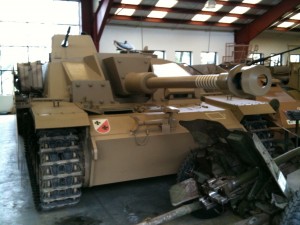 |
The sheer number of vehicles and equipment, from Scud missile launchers to Main Battle Tanks, were simply too much to take in on a single visit. I will definitely come back to this place sooner than later.
If there was a take-away from that visit that was a tad disconcerting, it was about the future of the collection. The founder had died in 2009, so the millions that had been poured into the collection in years past was no more. A foundation was now in place to preserve what was already in the collection. But the various vehicles that were still in different stages of restoration would, in all likelihood, would no longer be completed.
A return visit, therefore, is not merely an indulgence, but a show of support for a unique vision.
I was 15 when a Soviet nuclear power plant in Chernobyl, Ukraine suffered a catastrophic accident. It was the story of the year, and was an event that my dad and I pored over with great curiosity, but with little concern. It was half a world away, so the biggest threat to the Philippines at the time was the rumored possibility of radioactive milk being exported to the Philippines. As the story went, milk that couldn’t be sold in Europe because of fears that cows had ingested irradiated feed, would be exported to other parts of the world. Back then, department stores in Davao had gotten into practice of selling re-packed powdered milk, and our family jokingly called this “Chernobyl milk”. We stuck with canned or liquid milk.
The reactor accident in Fukushima, Japan, on the other hand, was much closer to home. As horrific as the effects of the tsunami of the 11th of March were, the plant appeared to be a problem with wider implications. My wife is visiting the Philippines, and the rest of my family is still there. So this was a problem with a personal dimension, unlike the crisis in 1986.
The search for nerve-calming information started not long after reports of an explosion at the plant surfaced in the media.
NHK World reported that the event at the facility called Fukushima Number One was rated as a “Level 4” event. Useful information for a keyword search, which lead me to the following document:
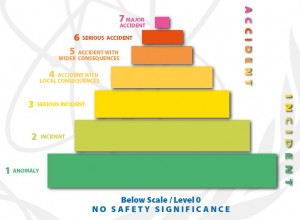 |
http://www.iaea.org/Publications/Factsheets/English/ines.pdf
The document above was a significant relief. Chernobyl had been a Level 7, and the Three-mile Island incident in 1979 was Level 5. The Japanese problem was an “Accident with local consequences”, so apparently wasn’t as bad as the aforementioned accidents.
Another intellectual tranquilizer I found came in the form of a blog put together by an Australian living in Japan for the benefit of his family in Australia. The post entitled “Why I am not worried about Japan’s nuclear reactors” is based on a letter from Dr. Josef Oehman, at the Center for Technology, Policy, & Industrial Development at MIT. Although Dr. Oehman’s expertise is in supply chains, his father was reportedly involved in the German nuclear industry.
Here is an interesting excerpt
I have been reading every news release on the incident since the earthquake. There has not been one single (!) report that was accurate and free of errors (and part of that problem is also a weakness in the Japanese crisis communication). By “not free of errors” I do not refer to tendentious anti-nuclear journalism – that is quite normal these days. By “not free of errors” I mean blatant errors regarding physics and natural law, as well as gross misinterpretation of facts, due to an obvious lack of fundamental and basic understanding of the way nuclear reactors are build and operated. I have read a 3 page report on CNN where every single paragraph contained an error.
To read the rest of the blog, click the following:
https://morgsatlarge.wordpress.com/2011/03/13/why-i-am-not-worried-about-japans-nuclear-reactors/
You be the judge of Dr. Oehman’s analysis. On my end, the two tid bits of information above have me at ease . . . for now at least.
Its the Visacollector’s nightmare: having your host country fall apart around you. Today, that country is Libya — a country to which I have never been, situated in a region that remains on my long list of unvisited places.
This north African trouble-spot has become the latest Arab nation to experience the uncertainty brought about by poplular unrest, not unlike “People Power” in recent Philippine history. But unlike our leaders who restrained their troops, the powers in this country unleashed them. (See here: Bloodbath in Libya)
In response to this development, the Philippine embassy has raised its alert level for the country to “Level 3 – voluntary repatriation”, and has setup a 24-hour hotline for Filipinos in the country who require assistance and wish to leave: 834-4580
The DFA reports that there are roughly 30,000 Filipinos in Libya. The bulk found in Tripoli and Benghazi and Al-Baida, with the rest scattered throughout the country. How many more undocumented Filipinos exist in the country is unclear.
Additional details available on the DFA Website: Repatriation
After having travelled far and wide to experience snow, looks like there’s a 50-50 chance that it will actually snow in the Bay Area itself. No travelling up winding roads to the mountains. We’re talking snow in the low-lands.
As per the San Jose Mercury News (see here), an Alaskan cold front due to arrive here on Thursday could bring the mercury low enough to cause frozen precipitation. If it does, it will reportedly be the first time this has happened since February 1976.
Its such a rare event, that the last time it snowfall occurred, a San Jose resident went outside, made a snowball, placed it in a peanut butter jar and saved it for posterity. She still has it (See here).
I took a friend to Portola Valley last Saturday, and up there (ironic name for a mountainous area) we did encounter snow on the ground. Its been a pretty cold winter.
Will history be made on Friday the 25th? Stay tuned.
The Philippine consulate consulate in San Francisco CA is a pleasant place to renew travel papers, certify documents, and other similar transactions. It’s is neat and organized. The consulate occupies space at the Philippine Center along Sutter St. within which a variety of establishments address a variety of Filipino concerns, from travel to sending money home. A nice one-stop-shop. The consulate is on the 6th floor.
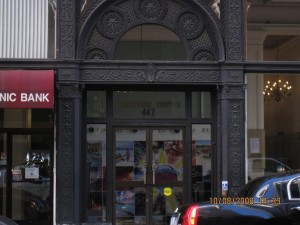 |
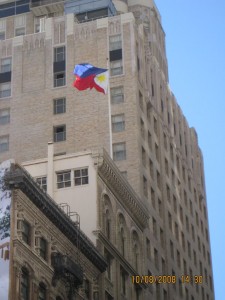 |
Unlike other embassies, which can be found in the hilly residential parts of the city, the Philippine Consulate is situated in a commercial area. Street parking, therefore is a valid option, but more often than not is unavailable. Embassy staff recommend the following parking lots listed in the picture on the left.
Personally, I favor the Sutter-Stockton Garage. Its within a stone’s throw from the Philippine Center and is not claustrophobic.
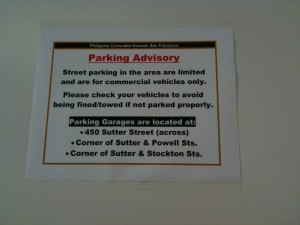 |
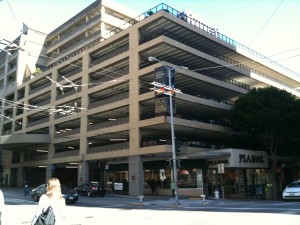 |
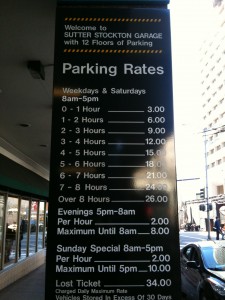 |
Each time we visit this consulate, which is typically a year or so apart, we always notice improvements to their service offerings. We processed my wife’s passport extension (more about why on another post) yesterday, and changes were readily apparent. The following sign greets when you step out of the elevator.
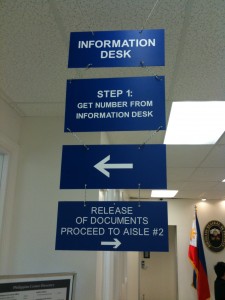 |
These weren’t there the other year. The overall layout had changed, and there were more desks for various consulate services, from passport renewal to processing of notarized documents.
Convenience was a focal point of many improvements. There is now an ATM in the waiting room, which particularly useful given that they neither accept personal checks nor credit/debit cards for their services. For those who neglect to bring copies of key documents, citizens can avail of a self-service photocopier for $0.25 per copy. This used to be situated at a rather odd location outside the main waiting area. These days these machine are now situated in the waiting area.
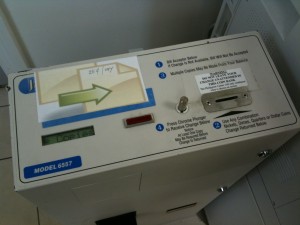 |
Now that my wife’s passport renewal has been processed, I probably won’t be back till I apply for an ePassport next year. Looking forward to next year’s surprises.
To the folks at the San Francisco Consulate: “Keep up the good work”.
A few years ago, my brother and his wife visited us for a few days. We don’t live in one of the major bay-area cities, so we had to drive a fair distance to see the sights. From the Golden Gate bridge in San Francisco, to the world-famous aquarium in Monterey.
The first time we stopped for gas, my brother got out of our CR-V with me to watch me fill up. “It was about time I learned how to fill up by myself”, he said. That caught me by surprise. He moved to the US east coast back in 1993, 11 years before I did, so this just didn’t compute.
Until that visit, I had come to believe that unattended gasoline stations, save for a solitary employee manning the cash register, were the norm for the US as a whole. I had come to accept this as just one of many things that set this country apart from the Philippines, where gas attendants abound.
That apparently wasn’t the case. My brother’s home state of New Jersey, for example, still had attendants. A co-worker would later share that there are actually some states that don’t allow drivers to pump fuel themselves.
I learned to operate a fuel pump on my second day in California. My boss back then walked me through the process of getting my first rental car, and immediately afterward led me to a gas station and taught me to work the pump. To this day, I flip the nozzle to drain residual fuel from the hose into my tank — just as she taught me that sunny 3rd of May.
The fill-up process is straight-forward for most gas machines. However there are less-than-well-designed ones out there that will will require a bit of probing. But the basic operating steps pretty much remain the same.
The approach
When driving up to a machine, it usually helps to know which side of your car permits access to the gas tank. This probably isn’t much of a concern when driving your own car. But if you travel a lot, and have to deal with a plethora of rental cars, not being mindful about this can result in the occasional three-point-turn at the gas station parking lot.
Fuel gauges offer aid in this regard. Note the samples below. On some cars, the side where the gas pump is on the fuel gauge corresponds to the location of fuel tank access. On others, the location is indicated by an arrow.
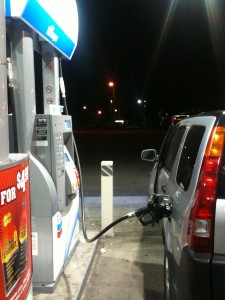 |
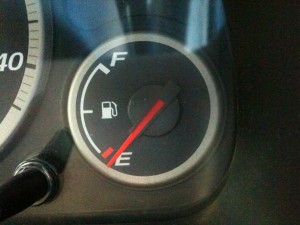 |
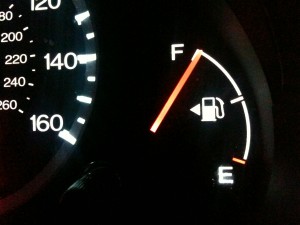 |
The photos above were taken from a Honda CR-V and a Honda Accord. Both of which have their fuel tank access on the driver side. The following photo is from a friend’s Mazda which has its access door on the passenger side.
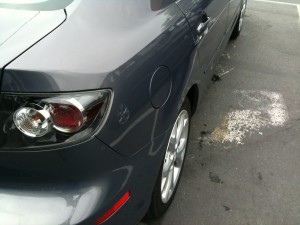 |
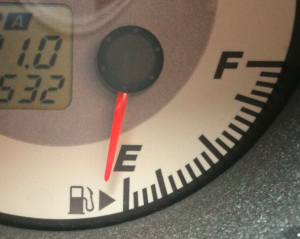 |
Most pump consoles will walk you through the fueling process. The photo below shows what most start screens look like.
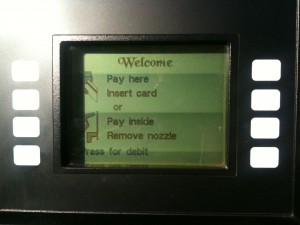 |
They typically assume the following sequence:
1. Choose a payment method: cash paid directly to the cashier or via debit/credit card
2. Choose fuel type
3. Remove nozzle from its cradle and then insert into fuel tank receptacle
4. Begin fueling
5. Return nozzle to cradle
6. Wait for additional instructions
Payment method
Unless the credit card reader on the pump isn’t working, I typically prefer to use a card. Its faster and you can just let the pump figure out how much gas your car needs (See nozzle discussion below). If you pay through the cashier, you have to guesstimate how much fuel you need because they’ll ask for a dollar value.
Choose fuel type
Pumps segregate gasoline by octane levels. The higher the octane rating, the more expensive the fuel. Refer to your car’s documentation for the appropriate fuel type for your vehicle. When driving a rental car though, I always go cheap.
Some pumps have a single nozzle for all three types. Others have nozzles for each. Watch out for machines that also offer both gasoline and diesel. Diesel nozzles are typically in a different color from those dedicated to gasoline.
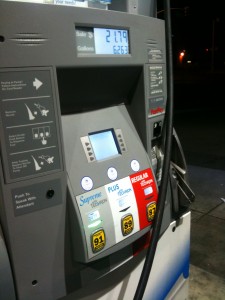 |
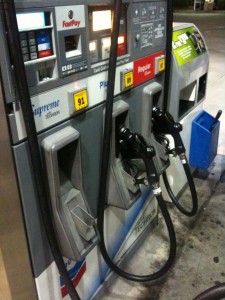 |
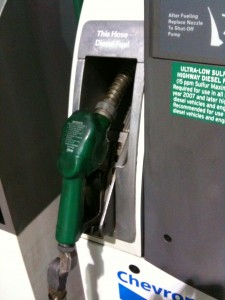 |
| Gasoline, single-nozzle | Gasoline, multi-nozzle | Diesel |
Insert nozzle . . . begin fueling
Fuel won’t flow till either the credit card is authorized, or the cashier approves the sale. Once approved, fueling can begin. Unscrew the fuel cap, insert the nozzle into the fuel tank, squeeze the lever, and then engage the lock (shown on the picture on the right).
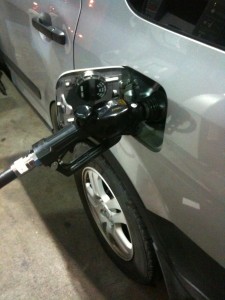 |
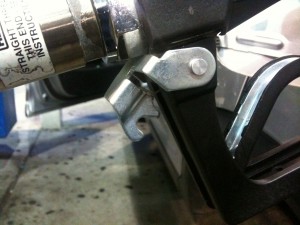 |
Nozzle locks are great. They allow you to do other things while fueling, like cleaning your car’s windshield or grabbing a quick bite at the station convenience store. Once the tank is filled, a sensor in the nozzle automatically disengages these locks, making the fueling process painless.
While researching for this post, I was surprised to learn that there were literally dozens of nozzle brands. Here’s a sampling. One key difference between nozzles is the location of the lock. The photo above only shows one design. Others, like the one shown below, have the lock within the lever guard itself.
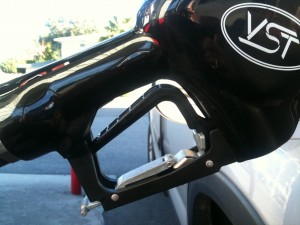 |
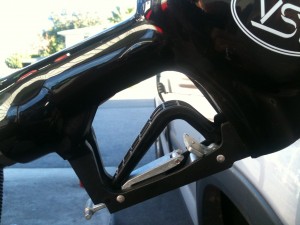 |
|
| Locked, fueling | Released |
Return nozzle to cradle
Once fueling is done, and the nozzle is safely back in its cradle . . . don’t forget to screw the fuel cap back on.
Interestingly enough, forgetting this final step is not an all-too-rare occurrence. Googling for the terms “gas cap” + “forgot” yields a fair number of results. It’s . . . like . . . a special club.
My first weekend with my first rental car also marked the first time I took it to a gas station by myself. I’d been driving along city streets to work all week, and hadn’t been on the freeways yet. I resolved to change that that Saturday and figured that I’d tank up before did so.
I pulled up to a Union 76 close to my temporary apartment, filled up, and mentally went over my freeway route while waiting for the click of the nozzle lever that signaled a full tank. That click didn’t take long since I hadn’t really been driving around very much. Ready or not, the Interstate run was on.
While filling up, a police car pulled up to the fuel pump ahead of me. As I was getting ready to go, I couldn’t help but notice that the policeman was staring at me through his side mirror. Flashing lights and sirens didn’t mark my departure from the station. So I figured that was that.
Upon arrival at my destination, I discovered what he was staring at. Like a black tassel hanging from the side of the car, my fuel cap was hanging by its restraining cord, below a fully open fuel door. Happily it wasn’t raining.
Wait for additional instructions
Some gasoline stations use their machines to up-sell other services. Car wash services, for example, are often offered at a discount.
Make sure you answer all the prompts on the console to prevent others from taking advantage of your purchase.
This is a reasonable snapshot of how things go in California. Moving forward, will be more mindful of the experiences in other states. Till then . . . happy fueling.